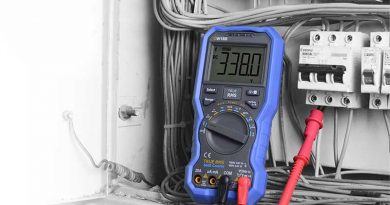Multimeters and Resistance Testing
A digital multimeter is an electronic measuring instrument that combines several different measurement functions in one compact unit, making it easy to see what is going on inside a circuit. Because you don’t need to move the dial to measure different levels, auto-ranging multimeters are especially useful. If you want to get the most out of your multimeter be sure to read the manual which will explain basic operation and pertinent safety information. Let’s look at some basic resistance testing you can do with your digital multimeter.
To test the resistance you’ll first set the multimeter to “resistance,” and then check that both probes are inserted into the appropriate holes. Note the readout of the multimeter when the probes aren’t touching anything; because air doesn’t conduct electricity, there is an infinite resistance separating the probes when they are apart, and this infinite resistance varies from multimeter manufacturer to manufacturer. After that touch the two probes together. Since the metal tips of the probes conduct electricity very well the resistance should be nearly zero.
Measure the resistance of some loose resistors, i.e. resistors not attached to a circuit. Test resistors of various ohm values. Then touch the multimeter’s probes to the wires on the sides of a resistor’s central cylinder. Pay attention to the units — “k” means kiloohms (thousands of ohms) and “M” refers to megaohms (millions of ohms). You can find resources online that help you identify the value of a resistor based on its colored bands.
Don’t measure resistance in a circuit when electricity is coursing through it. Furthermore, you need to discharge capacitors before measuring resistance because you will get false readings if there is any other source of current other than the multimeter. If your circuit has large capacitors you must test them using a voltmeter set to high direct current (DC) voltage to ensure they aren’t carrying a charge. Use a high-wattage resistor to discharge the capacitor if you find that it’s carrying a charge: cautiously touch the the resistor’s leads to the capacitor’s leads. Be patient as it may take several seconds for the capacitor to fully discharge.
